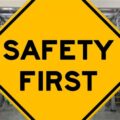A fire extinguisher can be defined as an active fire protection device used to extinguish or control small fires, often in emergency situations. It is not intended for use on an out-of-control fire, such as one which has reached the ceiling, endangers the user (i.e., no escape route, smoke, explosion hazard, etc.), or otherwise requires the expertise of a fire brigade. Typically, a fire extinguisher consists of a hand-held cylindrical pressure vessel containing an agent that can be discharged to extinguish a fire. Fire extinguishers manufactured with non-cylindrical pressure vessels also exist but are less common.
Types of Fire Extinguishers
Water and foam extinguishers
Water and Foam fire extinguishers extinguish the fire by taking away the heat element of the fire triangle. Foam agents also separate the oxygen element from the other elements. Water extinguishers are for Class A fires only – they should not be used on Class B or C fires. The discharge stream could spread the flammable liquid in a Class B fire or could create a shock hazard on a Class C fire.
Carbon Dioxide extinguishers
Carbon Dioxide fire extinguishers extinguish fire by taking away the oxygen element of the fire triangle and also be removing the heat with a very cold discharge. Carbon dioxide can be used on Class B & C fires. They are usually ineffective on Class A fires.
Dry Chemical extinguishers
Dry Chemical fire extinguishers extinguish the fire primarily by interrupting the chemical reaction of the fire triangle. Today’s most widely used type of fire extinguisher is the multipurpose dry chemical that is effective on Class A, B, and C fires. This agent also works by creating a barrier between the oxygen element and the fuel element on Class A fires. Ordinary dry chemical is for Class B & C fires only. It is important to use the correct extinguisher for the type of fuel! Using the incorrect agent can allow the fire to re-ignite after apparently being extinguished successfully.
Wet Chemical extinguishers
Wet Chemical is a new agent that extinguishes the fire by removing the heat of the fire triangle and prevents re-ignition by creating a barrier between the oxygen and fuel elements. Wet chemical of Class K extinguishers were developed for modern, high efficiency deep fat fryers in commercial cooking operations. Some may also be used on Class A fires in commercial kitchens.
Clean Agent extinguishers
Halogenated or Clean Agent extinguishers include the halon agents as well as the newer and less ozone depleting halocarbon agents. They extinguish the fire by interrupting the chemical reaction and/or removing heat from the fire triangle. Clean agent extinguishers are effective on Class A, B and C fires. Smaller sized handheld extinguishers are not large enough to obtain a 1A rating and may carry only a Class B and C rating.
Dry Powder extinguishers
Dry Powder extinguishers are similar to dry chemical except that they extinguish the fire by separating the fuel from the oxygen element or by removing the heat element of the fire triangle. However, dry powder extinguishers are for Class D or combustible metal fires, only. They are ineffective on all other classes of fires.
Water Mist extinguishers
Water Mist extinguishers are a recent development that extinguish the fire by taking away the heat element of the fire triangle. They are an alternative to the clean agent extinguishers where contamination is a concern. Water mist extinguishers are primarily for Class A fires, although they are safe for use on Class C fires as well.
Cartridge-Operated Dry Chemical extinguishers
Cartridge Operated Dry Chemical fire extinguishers extinguish the fire primarily by interrupting the chemical reaction of the fire triangle. Like the stored pressure dry chemical extinguishers, the multipurpose dry chemical is effective on Class A, B, and C fires. This agent also works by creating a barrier between the oxygen element and the fuel element on Class A fires. Ordinary dry chemical is for Class B & C fires only. It is important to use the correct extinguisher for the type of fuel! Using the incorrect agent can allow the fire to re-ignite after apparently being extinguished successfully.
Three Ways to Check Fire Extinguishers
Depending on the type of inspection being performed, there are different recommendations and requirements for the time between inspections. Here are three ways fire extinguishers need to be tested, and the schedule for each.
- Visual Fire Extinguisher Inspections – Once per Month.
Employers must perform a visual inspection on portable fire extinguishers at least once per month. This is also a good benchmark for homeowners to follow. Visually inspecting your fire extinguishers helps ensure several important points:
- The extinguisher is still present in its designated location
- No damage has occurred to the equipment
- No obstructions are blocking the equipment from view or from easy access
- The extinguisher is fully charged and operational
- What should you look for during a visual inspection?
Look for obvious signs of physical damage, such as corrosion, leakage, or dents.
Check the pressure gauge to make sure the indicator is in the operating range.
Make sure the pull-pin is not missing and the pull pin seal is intact.fire extinguisher pull pin
Verify the date of the last professional inspection.fire extinguisher inspection tag
Date and initial the back of the tag to log the monthly visual inspection.
- Maintenance Inspections – Once per Year
Employers need to perform a full maintenance check on their workplace’s portable fire extinguishers once per year. “Maintenance” means a thorough examination and repair, as needed, of all your facility’s portable fire extinguishers. Annual fire extinguisher maintenance inspections should be performed by a professional fire protection company.
These companies have the proper tools and training to ensure optimal compliance while recognizing and correcting any potentially hazardous situations. Once a fire extinguisher passes its annual maintenance, it is verified with a dated inspection tag. That tag is good for one year from the date indicated. If the unit fails to pass the inspection, it must be repaired or replaced.
- Internal Maintenance Inspection – Every 5, 6, or 12 Years (depending on equipment type)
This internal maintenance also requires the services of a fire protection company. Internal maintenance testing involves discharging of the fire extinguisher and a complete internal examination and recharging to insure all components of the fire extinguisher are working correctly. Extinguishers such as the dry chemical type requiring a 12 year hydrostatic test also require a 6 year internal examination.In addition to or as part of the internal maintenance examination, periodically the fire extinguisher cylinders must be hydrostatically tested to ensure their integrity and ability to safety contain the pressure used to expel the agent.
Typically, pressurized water, carbon dioxide, and wet chemical extinguishers need to be hydrostatically tested every 5 years. Dry chemical extinguishers need to be tested every 12 years. Proper testing and maintenance of your workplace’s portable fire extinguishers does more than fulfill regulatory requirements—it ensures the safety of your employees and your business.






